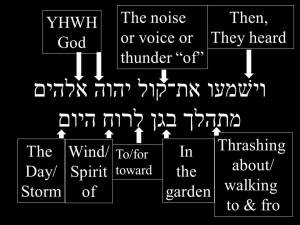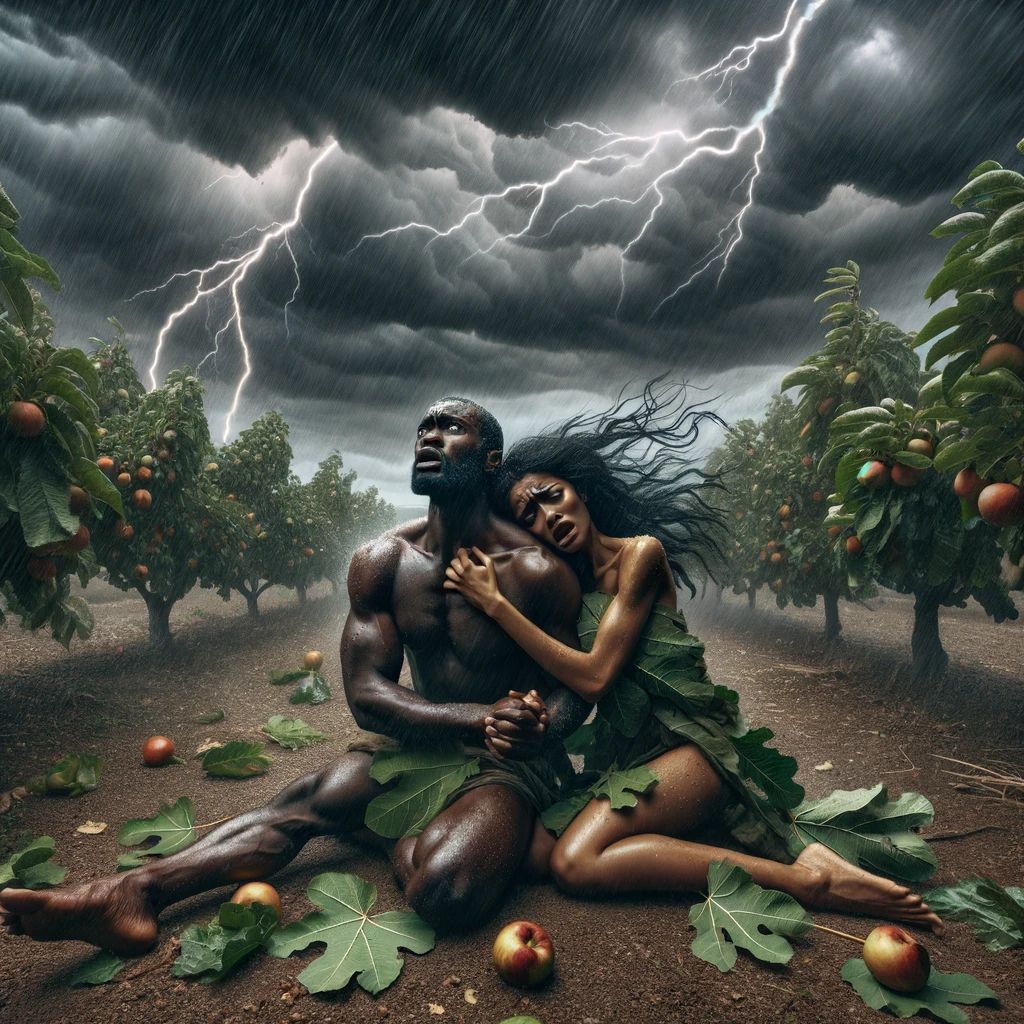In my last blog I began discussing issues of grammar and word meaning in Genesis 3:8. The text is typically translated with something akin to “And they heard the sound of the LORD God walking in the garden in the cool of the day, and the man and his wife hid themselves from the presence of the LORD God among the trees of the garden,” but suffers from an overly massaged translation. This is mostly because the actual “word for word” sense would be opaque to most and is fraught with ambiguous words.
 They heard the sound or voice or thunder or crashing of God as he came walking about or pacing or thrashing about in the wind or spirit or breath or demeanor of the day or storm to judge his creatures who had rebelled against him… they flee in fear.
They heard the sound or voice or thunder or crashing of God as he came walking about or pacing or thrashing about in the wind or spirit or breath or demeanor of the day or storm to judge his creatures who had rebelled against him… they flee in fear.
For those who read this text with one lens this is a scene of shocked discovery on the part of God who comes for his evening stroll with Adam and Eve after a hard day’s work of managing the cosmos. He just can’t seem to find them and lo and behold to His divine amazement, they’re hiding from him and feel exposed being all naked and all.
For those who read this text within the ancient context of judgment scene, however, everything about this text screams “Storm Theophany.” They see an all knowing God thundering into the material world to confront His rebellious creatures who have defied His direct command and have every reason to feel exposed and to flee from his Holy presence. This text is read in light of every other judgment scene in which God comes thundering into the world to confront sinners in their sin or to save His servants (also a type of judgment scene called “ordeal.”
Whenever God appears in some form in the world of Man, we call this a Theophany—A THEO-Phany… a God appearance. Many instances in the Old Testament are considered Theophany.
- THE Angel of the Lord is considered a God Appearance. He appears to Hagar in Genesis 16:1ff.
- The Man who comes to Abraham with two companions in Genesis 18:1ff is a Theophany.
- So is the man who wrestles Jacob in Genesis 32:24-30.
- And so the Captain of Hosts in Joshua 5.
Sometimes, however, God appears in a display of the awesome and fearsome majesty of His divine nature—His Holiness. Scholars call this manifestation Glory Theophany or Storm Theophany, a this-world exposure of divine holiness. Kline calls it the Glory Spirit.[1]
Want to see it in Scripture? Watch for Wind, Cloud, Smoke, Fire, Brilliance, Storm, Lightening, Thunder, Earthquake, Tumult, Debilitating Fear, Trembling, Awe, and terms like Glory or Majesty. Glory or Storm Theophany is common in Scripture.
Psalm 18 has YHWH coming down in splendid power to defend the poet from his enemies, bowing the heavens, blasting the sea, shaking the mountains. In Genesis 15, YHWH shows up as a flaming firepot passing between the pieces of the covenant animals. In Exodus 3, YHWH appears in flame within the bush which burns but is not burned up. He appears as a pillar of cloud and fire during the exodus, and settles in terror upon mount Sinai at the giving of the ten commandments.
The judgment throne of the Ancient of Days in Daniel 7:9-10 apart from containing a figure arrayed in divine splendor, is made of flame with burning wheels and fire poured out from it. As the book of Job draws to a close, God shows up in judgment over the scene with a storm brewing and then breaking out upon them in a tempest and whirlwind (Job 38:1).
Isaiah 66:15 says, “For, behold, the LORD will come with fire, and his chariots shall be like the whirlwind; to render his anger with fury, and his rebuke with flames of fire.”
This, of course, is a mere sampling of the Glory/Storm Theophany texts. Even so, few have even considered adding Genesis 3:8ff to the list.
Genesis 3:8 is a vital part of Adam & Eve’s judgment Scene and the very fact that this IS a judgment scene should prepare us for Storm/Glory Theophany… unfortunately, since we are modern readers of an Ancient text whose world view is foreign to us, we miss all the cultural cues.
Indeed, translations for this passage were wrangled into their common shape long before the Christian community got their heads around the importance of storm theophany imagery and the importance of certain terms for conjuring this imagery in the minds of the original audience. Even the LXX translators, Greek Christians in Egypt, are upwards of a millennium removed from the bulk of these passages in the Old Testament.
In a powerful summary of the text when seen through eyes expectant in judgment scenes, trained by storm theophany Niehaus writes, “Man and woman are now in a fallen condition and can only have one reaction to the inbreaking of God’s glory; they hide out of fear. Adam attributes his fear to his nakedness but perhaps also to the thunder of God’s advance… Adam is, indeed, both physically and spiritually naked—or perhaps better, exposed. Exposed in all his sinfulness, he cowers before a holy God. Such fear or dread of the holy is, henceforth, a characteristic of human response in the OT to all theophanies that actually involve the glory of God.”[2]
[1] Meredith Kline, Images of the Spirit p. 13. Kingdom Prologue p. 20.
[2] God at Sinai pg. 159
Discover more from Biblical Literacy with Dr. Andrew D. Sargent
Subscribe to get the latest posts sent to your email.


